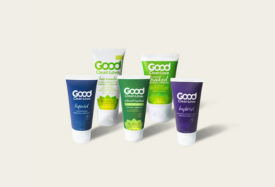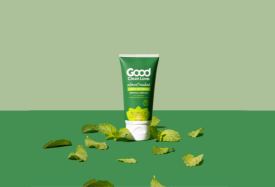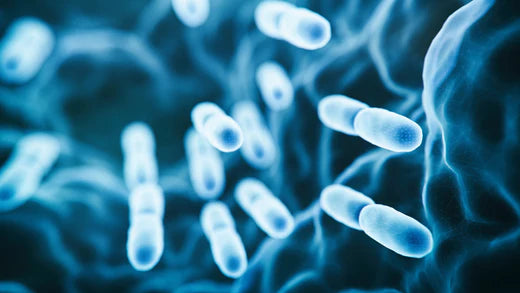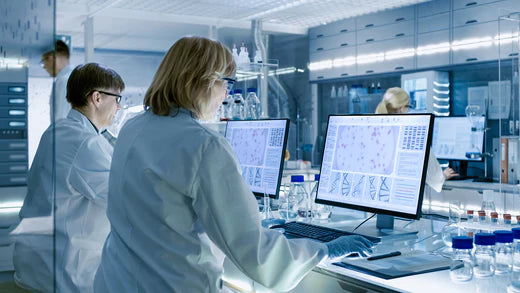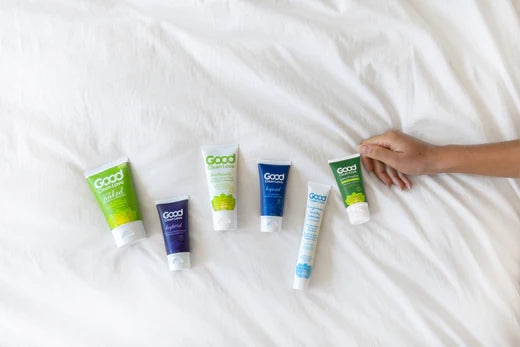Since I started working at Good Clean Love, I’ve grown more conscious of what I use on and put inside my body.
Every day we are exposed to hundreds, if not thousands, of chemicals. Between my shampoo, lotion, makeup, and toiletries, there is no way I could keep track of them all. That’s normal, and I assumed others would do the heavy work for me (the FDA, for example).
Quite frankly, the idea of all these chemicals floating around didn’t bother me too much before.Just because there are lots of ingredients in something doesn’t mean it is bad. In fact, I kind of resented the “fear of the unknown” that a lot of people have when it comes to science.
I mean, it’s not like I use tanning beds or huff hairspray, so I figured I was safe. Besides, I love makeup, shower gels, bath bombs, perfume, etc. If a little toxic exposure is the price to pay for smelling like a goddess, who am I to complain?
But this month our focus is on Breast Cancer Prevention. In the process of writing my last article,An Intro To Partner Breast Checks, I began to realize the enormity of this chemical soup we live in … and worse, the potential risks tied to some of my favorite products (which may be worth a little complaining).
Part of preventing breast cancer is avoiding exposure to toxic substances.Keep A Breast’s Non Toxic Revolution,Environmental Working Group’s (EWG) Skin Deep,The Campaign for Safe Cosmetics, andThink Pink, Live Green are just a few initiatives dedicated to raising awareness about the dangers of chemicals in our cosmetic products. Most specifically,parabens andphthalates.
What are parabens and phthalates, you might ask? And perhaps more importantly, why are so many groups trying to raise awareness about their existence?
Parabens are preservative chemicals used in many cosmetic products (and lubes! but not ours). They’re designed to prevent the growth of microbes, which sounds pretty innocent. And phthalates? They’re chemicals that help dissolve other ingredients into a consistent solution. They’re used for a host of reasons: from making plastic more flexible to fabricating hairspray and nail polish.
What do these chemicals have in common? They are biologically active, they can penetrate tissues, and they can interfere with your hormones. They both act on estrogen pathways, and in sufficient concentrations can mimic or block our hormones — making them endocrine disrupting chemicals, or EDC’s.
What are the risks associated with endocrine disruption? Well, you’ll have to pick your favorite. Hormones control so much in our bodies. There are more and more studies that suggest EDC’s in humans could be linked to effects as diverse as decreased sperm count, endometriosis, insulin resistance, obesity, and cancer, and may have a negative influence on fetal growth, early reproductive tract development, pubertal development, and neurodevelopment. While EDC’s occur naturally in products like soy milk, blueberries, and tofu, the ubiquity of their synthetic presence in cosmetics is causing concern.
So you can imagine my horror the other morning when I reached for my Lush body wash and found parabens all over the label. Ok, maybe not horror, but I did feel sort of betrayed. When I think of Lush, I think sustainable and ethical. But are methylparabens sustainable and ethical for my body? I agree that it is important for our products to have preservatives so that they don’t harbor pathogens, but at what cost? Lush ardently defends their usage of parabens, citing “studies” against them as“scare-mongering,” yet in the same breath ensures that they only use a little bit because they want the product to be as “mild” as possible and not hurt the “skin’s natural microflora.” They also claim they refrain from using them whenever possible. They seem to be contradicting themselves: why be so defensive about the potential dangers while simultaneously claiming that they use as little as possible? Curious, indeed.
And how long have I been using these types of products? Since puberty. It is a fact thatyoung girls and womenhave higher amounts of parabens in their urine than men, because paraben content is tied directly to the number of cosmetic products one uses daily. Now imagine the girls who will use these potentially toxic cosmetics from as young as thirteen until womanhood … that’s a lot of exposure.
I keep saying “potentially” harmful. Why?There is no direct link proving that parabens cause breast cancer,or any other cancer for that matter. In fact, the tests on paraben toxicity are ongoing. It’s difficult to link parabens to health hazards for three big reasons: first, “parabens” describes a large group of chemicals, and most likely only a fraction of those are harmful. Scientists suggest that“long-chain” parabens carry more risk because they have the strongest estrogenic activity. (In the case of Lush, methylparabens are shorter chemically and thus may be less problematic.) Moreover, It’s difficult to show cause and effect for an individual chemical in human subjects, especially when a single cosmetic product could contain combinations of dozens of these chemicals. Secondly, the concentration of these chemicals can determine their health risk. This is problematic for testing, because while an isolated chemical may test safe in small amounts, the compounded effect of many EDC’s mimicking hormones at once could have different results. While a small amount of an individual EDC may be safe, imagine the number of products you use in your daily hygiene routine. Finally, cosmetics aren’t tested for long-term health hazards, just immediate irritation — and that means these studies are not prioritized. Yes, fun fact: your cosmetics enter the market without ingredient testing for effectiveness or safetyIn fact, the FDA regulatesonlycolor additives in cosmetics.
So if the FDA doesn’t even regulate parabens, they must be safe right? Not exactly. The innocent until proven guilty treatment of chemicals is sort of unsettling, especially if we consider the example of phthalates. Phthalates, unlike parabens, have undergone extensive testing and documentation, and thus are subject tomore comprehensive regulations. Scarily enough, phthalates as a group were previously considered to have no risk at all, just like parabens. And as with parabens, it took a lot of work to discover that some types of phthalates were actually malignant — BBzp, DnBP, DEHP, and DiNP, just to name a few. DiNP was actuallycorrelated with male genital birth defectsand impaired reproductive function in a Swedish study. The FDA reports that they’re still reviewing data on the safety of parabens in cosmetic products, but who knows how long they will continue to go unregulated before we see a decisive statement? And, given that phthalates and parabens are both EDC’s, how long can we afford to wait?
It’s also important to keep in mind thatthis apparent lack of regulation is unique to the USA. It’s kind of insane when you realize that there are over 13,000 chemicals in our cosmetic industry, with more being introduced all the time, yet none of them are being tested for their long-term effects on humans. Europe has already banned many of the chemicals that we continue to smear on our faces and bathe with:over 1,300 cosmetics additives are banned in the EU. Comparatively, how many are banned in the USA? 11. And yes, a paraben is on the banned list —butylparaben, for its role in making men sterile.
Until the FDA finishes reviewing their data about other parabens, they will continue to be used in the majority of our cosmetics. Some people are fine with this — and that’s ok. Everyone is entitled to their own interpretation of risk. That’s life! As for breast cancer? It’s important to remember that thereis no proofcurrently that parabens are carcinogenic. However, among breast cancer organizations, there seems to be a uniting sentiment: live a preventative lifestyle. For some individuals, this means avoiding exposure to chemicals that mimic estrogen in the body. After all, estrogen can trigger the growth of hormone-receptor breast cancer cells, and it makes sense that some people would decide for themselves that having extra chemicals mimicking estrogen in their bodies isn’t worth the risk. For others, it is not a big deal. Personally, I felt empowered doing this research, because now I can read labels and make more informed consumer choices for myself. Unfortunately, even that can sometimes be difficult, because so many chemicals in cosmetics are hidden under blanket terms such as “fragrance.”
The intention of this article wasn’t to monger fear, but rather to bring these types of questions to light. I don’t think Lush is the worst in the cosmetics industry BY A LONG SHOT. They just happened to be in my shower when I was writing this article, and happened to contain parabens. In this case, methylparabensare allowed in the EU, so I’m convinced they’re probably fine. However, after writing this, I am more suspicious of Lush’s blanket statement that parabens are “used globally and are permitted by every world health authority” — clearly that’s not true. Maybe methylparabens are, but there are some that have clearly been called into question for the safety (butylparabens, for example). We should encourage critical thinking among consumers, not point fingers in order to lift up our own companies. So get curious and check your labels, folks!


